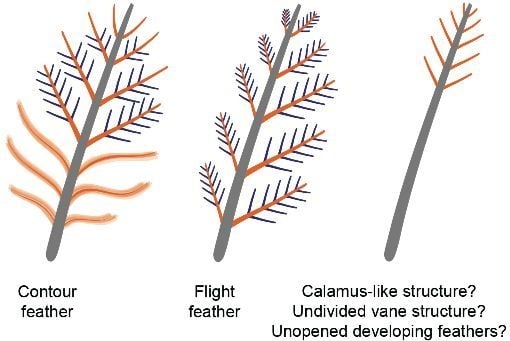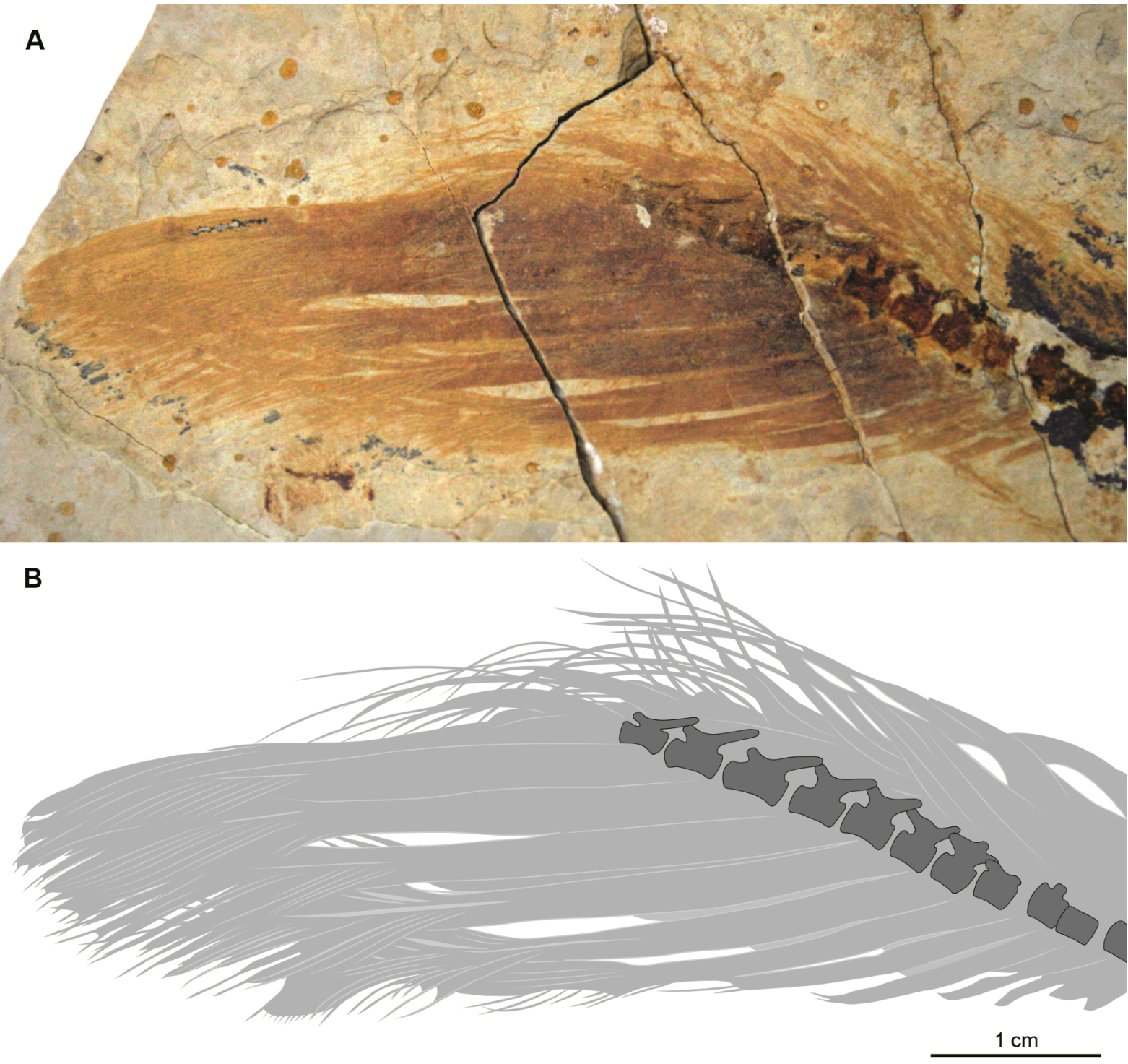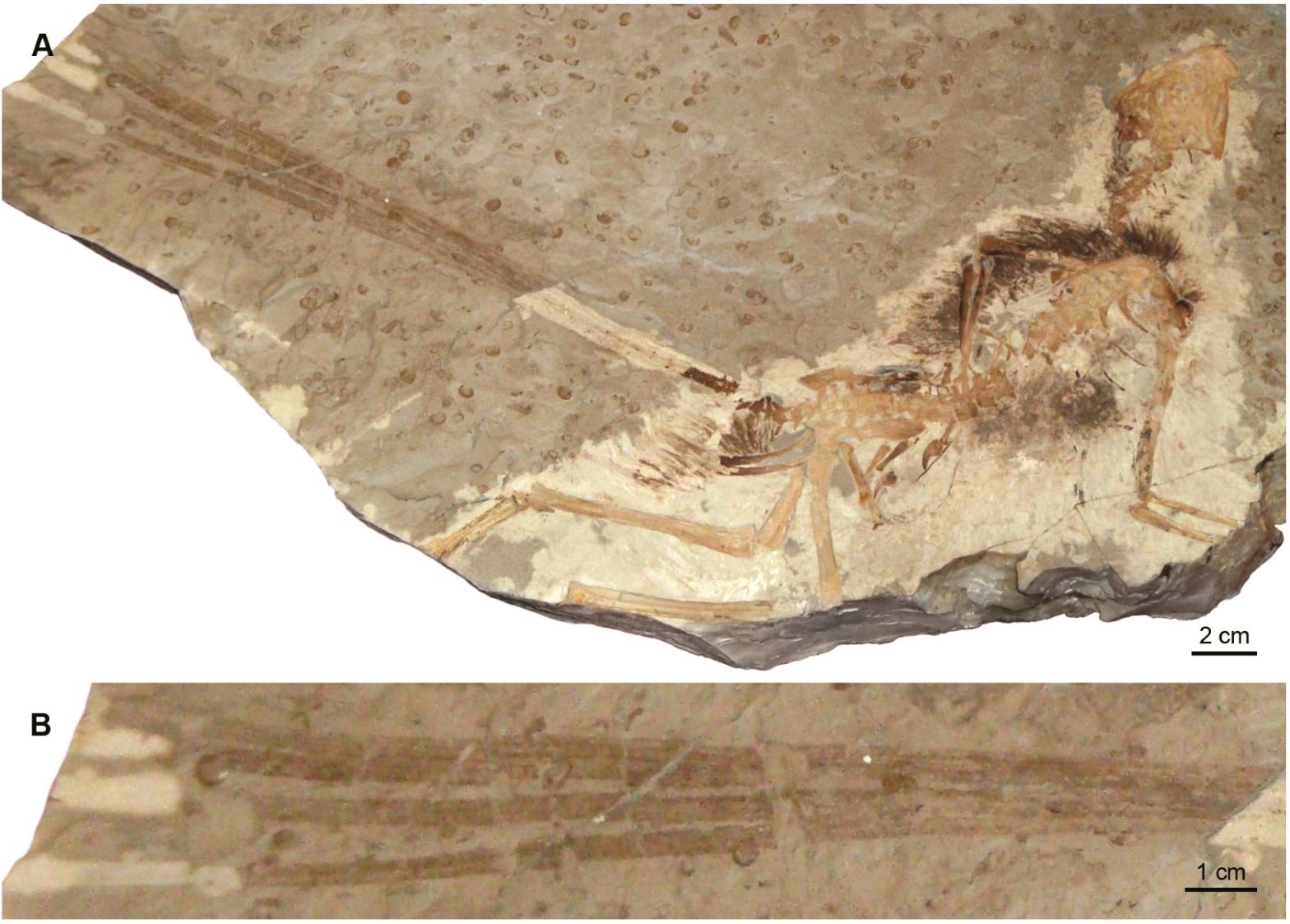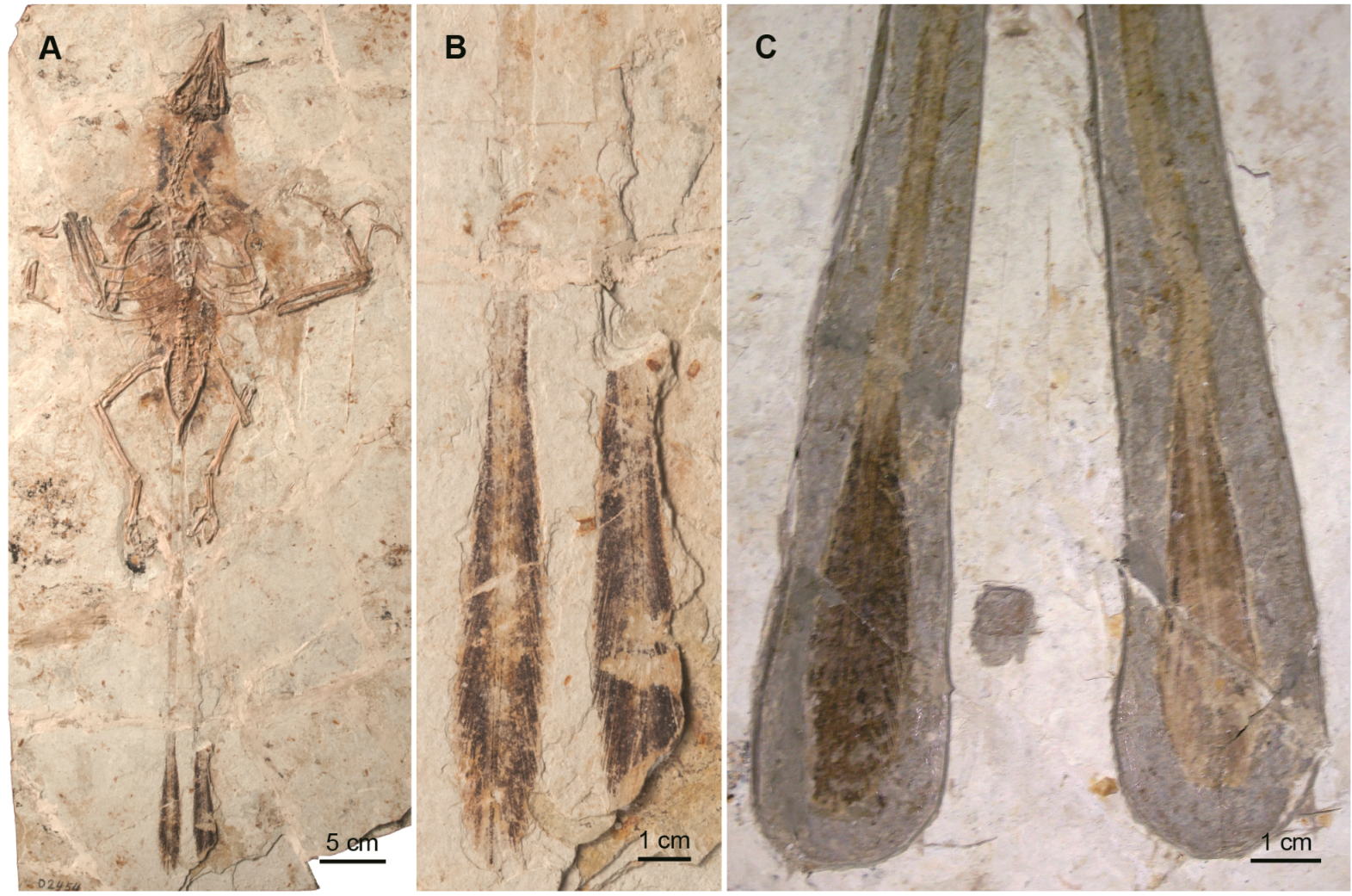Homology and Potential Cellular and Molecular Mechanisms for the Development of Unique Feather Morphologies in Early Birds
Abstract
:Institutional Abbreviations:
1. Introduction
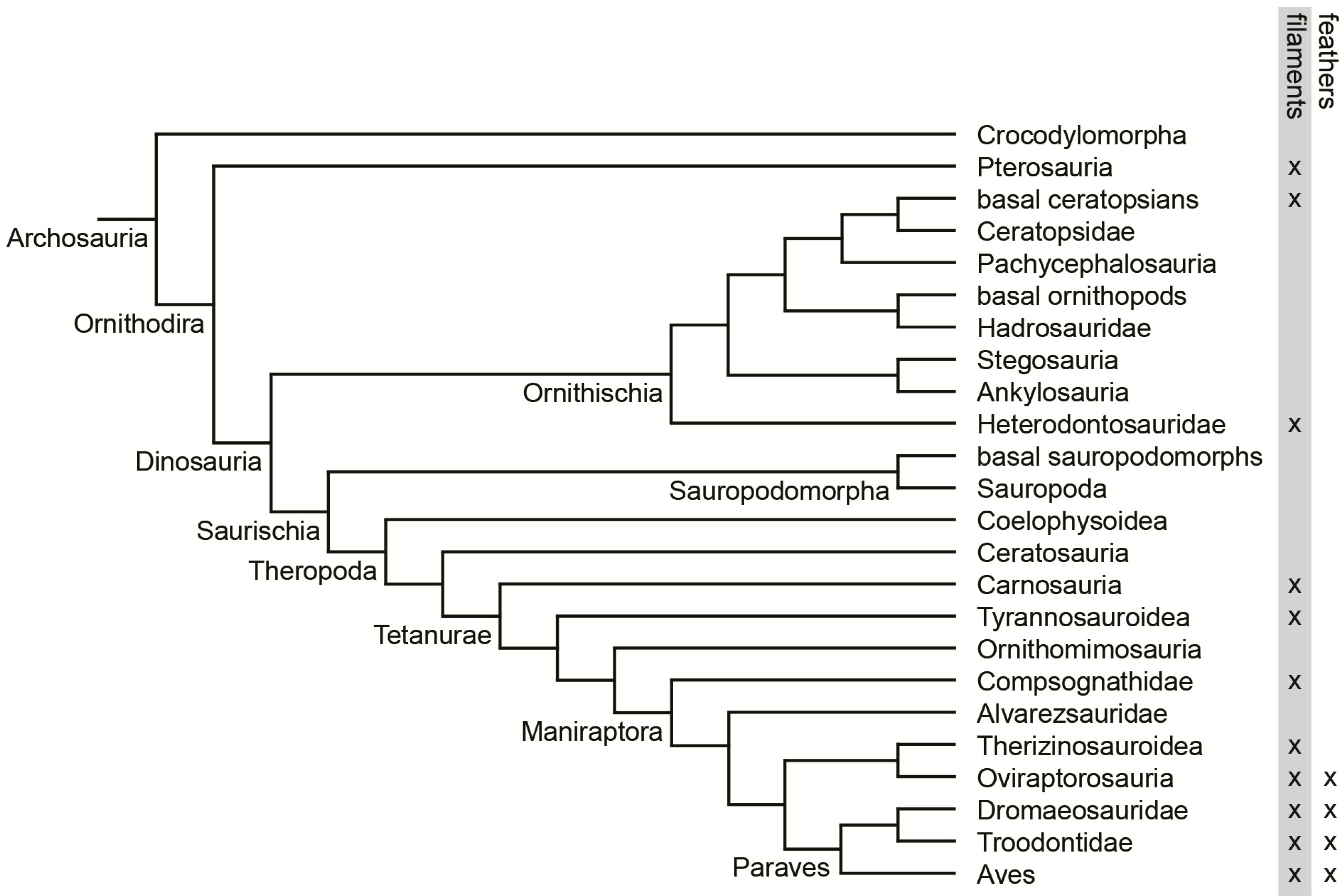
2. Morphological Description
2.2. Basal Birds
2.2.1. Confuciusornithiformes
2.2.2. Enantiornithes
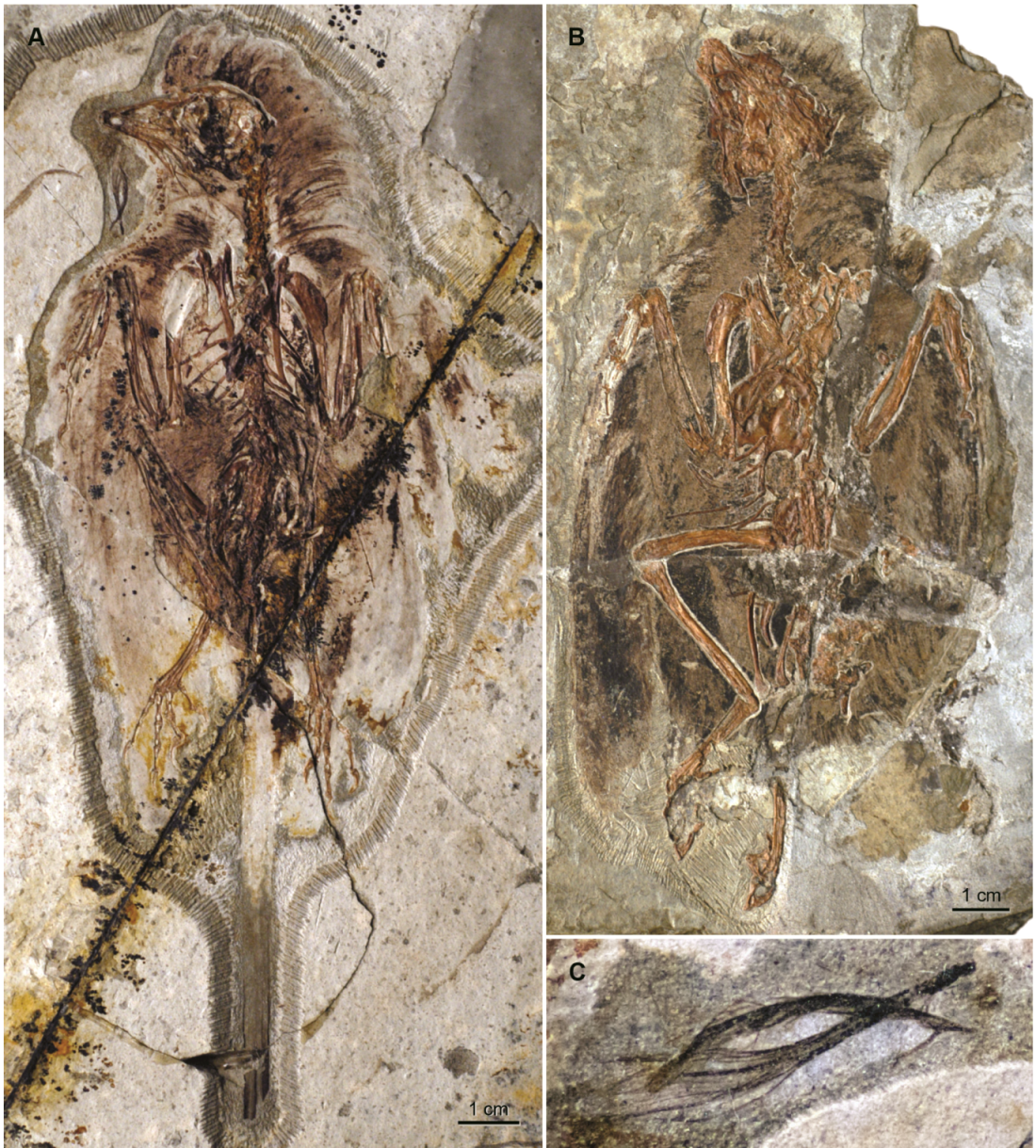
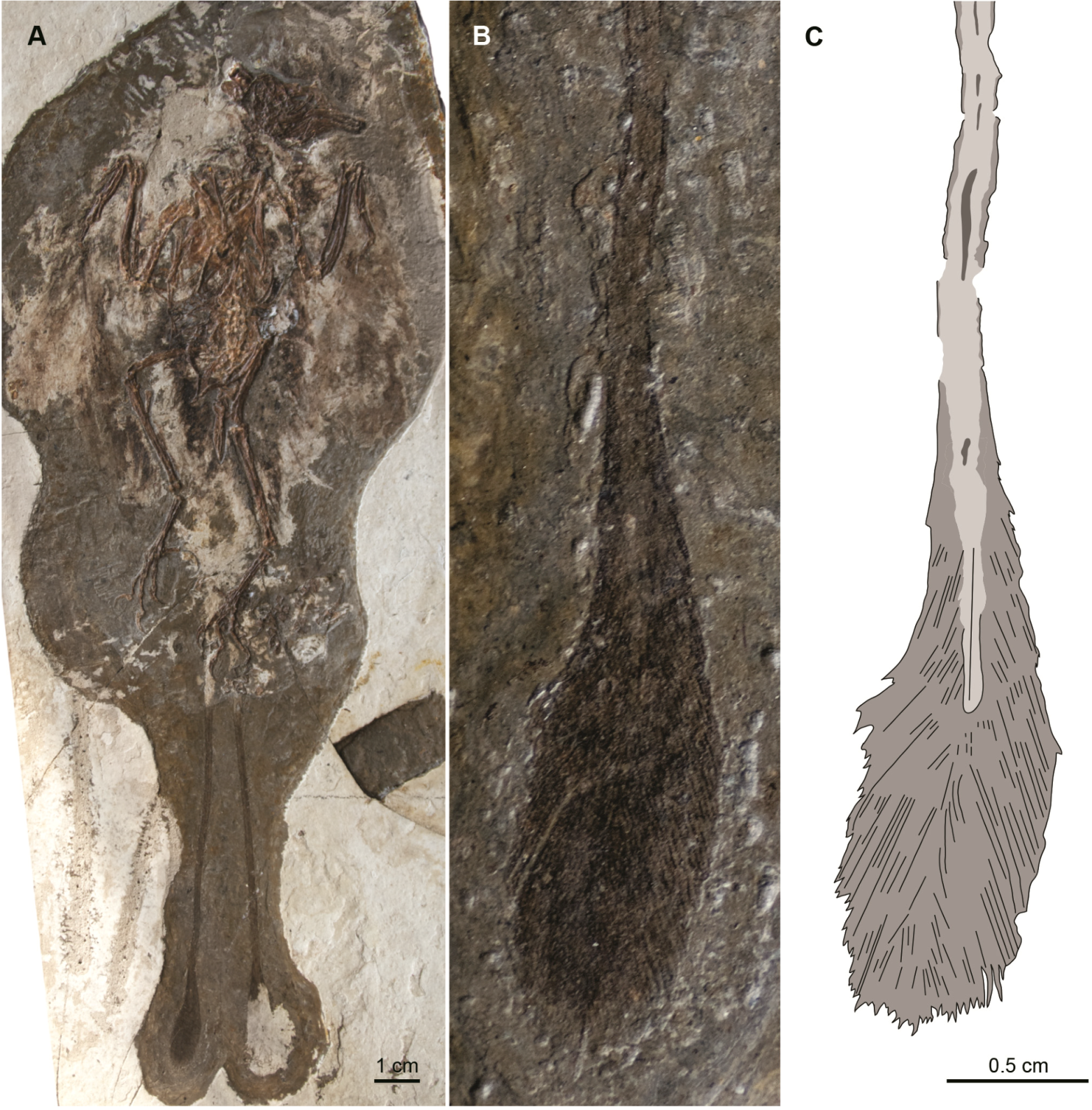

2.3. Comparison
3. Results and Discussion
3.1. Rachis Dominated Feathers
3.2. Potential Cellular and Molecular Basis for Evolution Novelty in Feather Morphogenesis
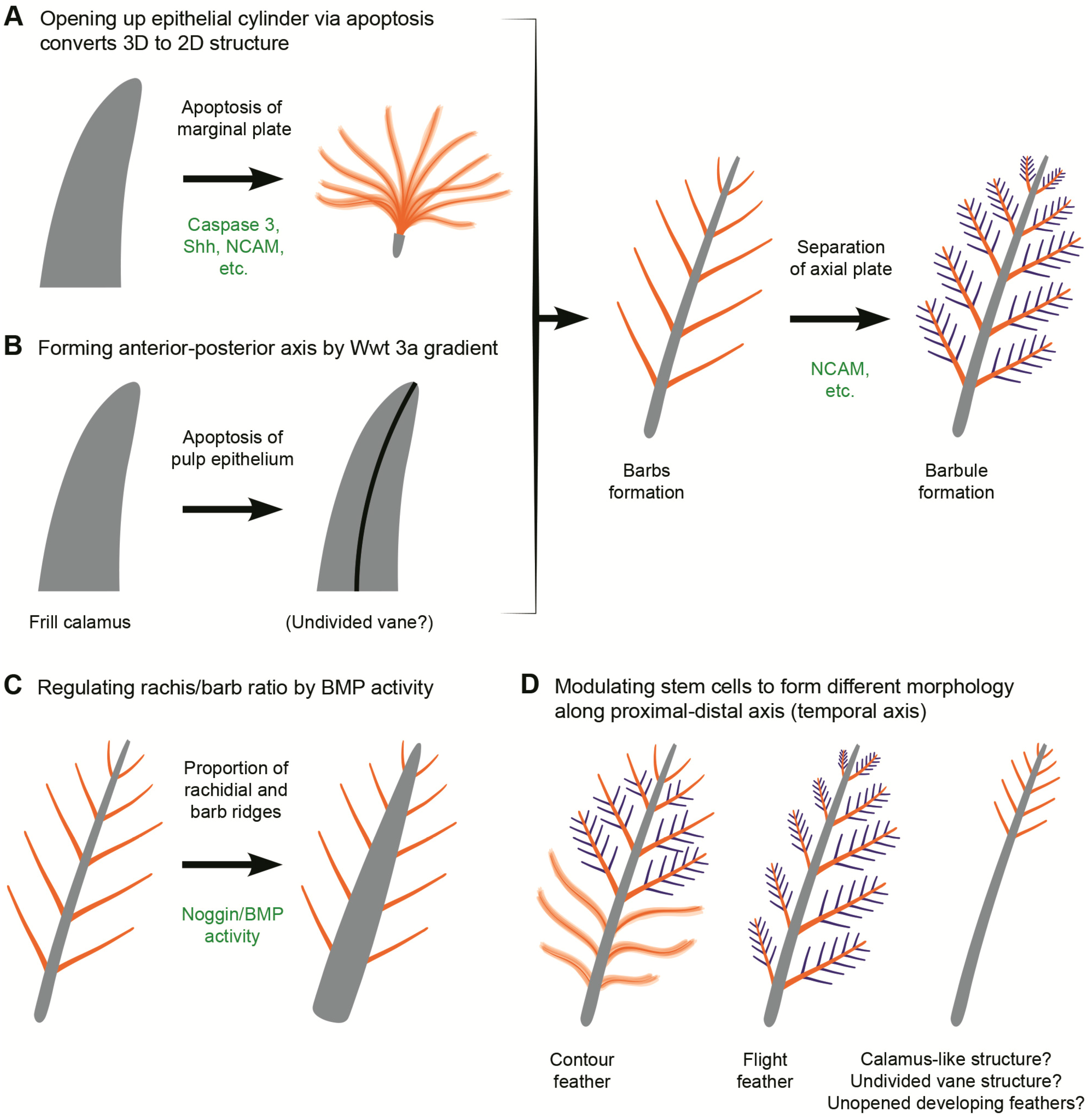
3.3. Function
3.4. Proximally Ribbon-like Pennaceous Feathers
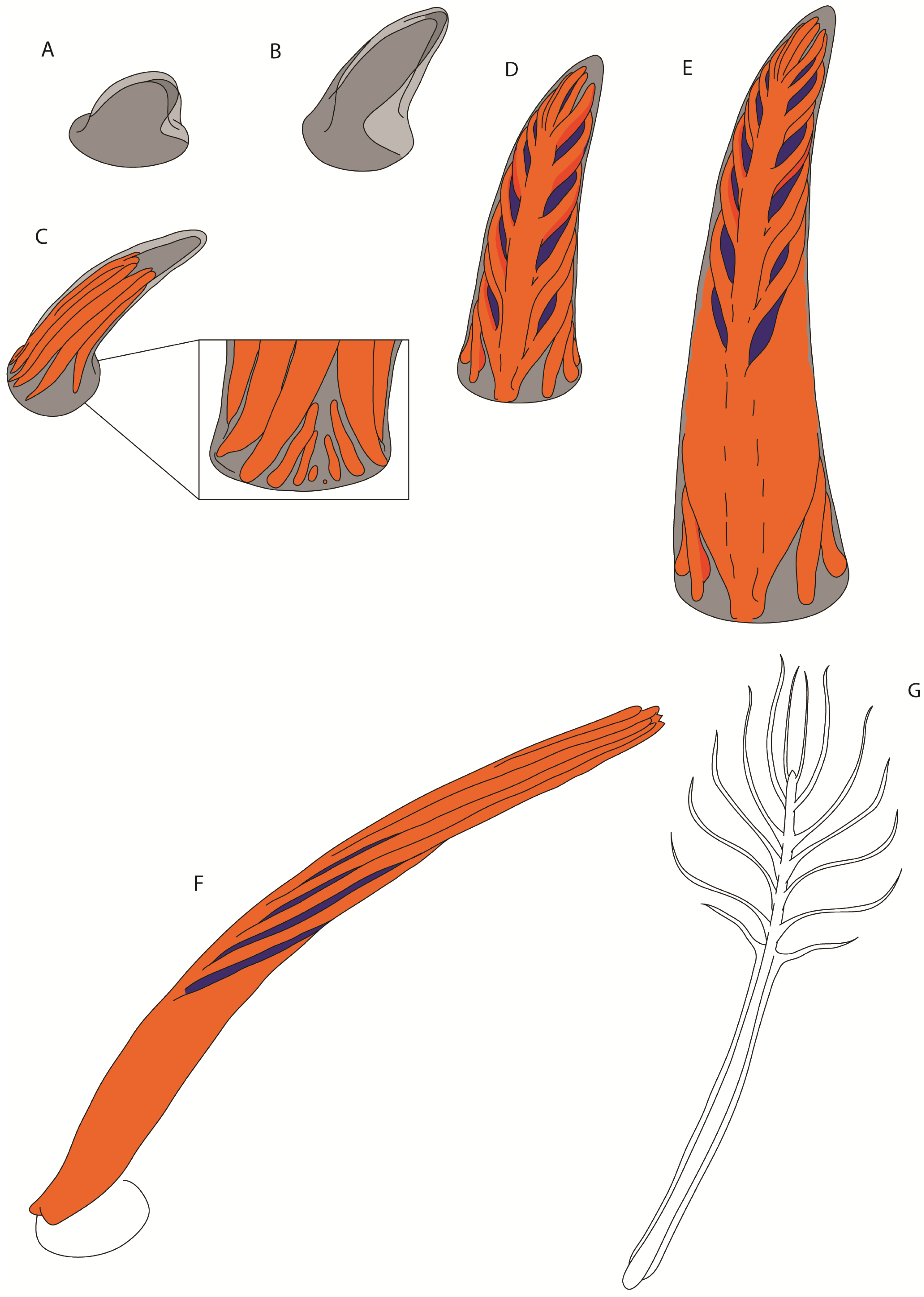
4. Conclusions
Acknowledgments
References
- Ji, Q.; Ji, S.A. On discovery of the earliest bird fossil in China and the origin of birds. Chin. Geol. 1996, 233, 30–33. [Google Scholar]
- Ji, Q.; Currie, P.J.; Norell, M.A.; Ji, S.A. Two feathered dinosaurs from northeastern China. Nature 1998, 393, 753–761. [Google Scholar] [CrossRef]
- Xu, X.; Zhao, Q.; Norell, M.A.; Sullivan, C.; Hone, D.W.; Erickson, G.M.; Wang, X.L.; Han, F.L.; Guo, Y. A new feathered maniraptoran dinosaur fossil that fills a morphological gap in avian origin. Chin. Sci. Bull. 2009, 54, 430–435. [Google Scholar] [CrossRef]
- Xu, X.; Zheng, X.T.; You, H.L. Exceptional dinosaur fossils show ontogenetic development of early feathers. Nature 2010, 464, 1339–1341. [Google Scholar]
- Zheng, X.T.; You, H.L.; Xu, X.; Dong, Z.M. An Early Cretaceous heterodontosaurid dinosaur with filamentous integumentary structures. Nature 2009, 458, 333–337. [Google Scholar]
- Zhang, F.C.; Zhou, Z.H.; Xu, X.; Wang, X.L.; Sullivan, C. A bizarre Jurassic maniraptoran from China with elongate ribbon-like feathers. Nature 2008, 455, 1105–1108. [Google Scholar] [CrossRef]
- Xu, X.; Wang, K.B.; Zhang, K.; Ma, Q.Y.; Xing, L.D.; Sullivan, C.; Hu, D.Y.; Cheng, S.Q.; Wang, S. A gigantic feathered dinosaur from the Lower Cretaceous of China. Nature 2012, 484, 92–95. [Google Scholar]
- Chuong, C.M.; Widelitz, R.B. Feather morphogenesis: A model of the formation of epithelial appendage. In Molecular Basis of Epithelial Appendage Morphogenesis; Chuong, C.M., Ed.; Landes Bioscience: Austin, TX, USA, 1998; pp. 57–74. [Google Scholar]
- Yu, M.; Wu, P.; Widelitz, R.B.; Chuong, C.M. The morphogenesis of feathers. Nature 2002, 420, 308–312. [Google Scholar] [CrossRef]
- Harris, M.P.; Fallon, J.F.; Prum, R.O. Shh-Bmp2 signaling module and the evolutionary origin and diversification of feathers. J. Exp. Zool. B Mol. Dev. Evol. 2002, 294, 160–176. [Google Scholar] [CrossRef]
- Chang, C.H.; Yu, M.K.; Wu, P.; Jiang, T.X.; Yu, H.S.; Widelitz, R.B.; Chuong, C.M. Sculpting skin appendages out of epidermal layers via temporally and spatially regulated apoptotic events. J. Invest. Dermatol. 2004, 122, 1348–1355. [Google Scholar] [CrossRef]
- Prum, R.O. Evolution of the morphological innovations of feathers. J. Exp. Zool. B Mol. Dev. Evol. 2005, 304, 570–579. [Google Scholar] [CrossRef]
- Lin, C.M.; Jiang, T.X.; Widelitz, R.B.; Chuong, C.M. Molecular signaling in feather morphogenesis. Curr. Opin. Cell Biol. 2006, 18, 730–741. [Google Scholar] [CrossRef]
- Alibardi, L. Cell structure of barb ridges in down feathers and juvenile wing feathers of the developing chick embryo: Barb ridge modification in relation to feather evolution. Ann. Anat. 2006, 188, 303–318. [Google Scholar] [CrossRef]
- Yue, Z.; Jiang, T.X.; Widelitz, R.B.; Chuong, C.M. Wnt3a gradient converts radial to bilateral feather symmetry via topological arrangement of epithelia. Proc. Natl. Acad. Sci. USA. 2006, 103, 951–955. [Google Scholar]
- Maderson, P.F.; Hillenius, W.J.; Hiller, U.; Dove, C.C. Towards a comprehensive model of feather regeneration. J. Morphol. 2009, 270, 1166–1208. [Google Scholar] [CrossRef]
- Mayr, G.; Peters, D.S.; Plowdowski, G.; Vogel, O. Bristle-like integumentary structures at the tail of the horned dinosaur Psittacosaurus. Naturwissenschaften 2002, 89, 361–365. [Google Scholar] [CrossRef]
- Xu, X.; Norell, M.A.; Kuang, X.; Wang, X.; Zhao, Q.; Jia, C. Basal tyrannosauroids from China and evidence for protofeathers in tyrannosauroids. Nature 2004, 431, 680–684. [Google Scholar] [CrossRef]
- Xu, X.; Guo, Y. The origin and early evolution of feathers: Insights from recent paleontological and neontological data. Vertebr. Palasiat. 2009, 47, 311–329. [Google Scholar]
- Hu, D.Y.; Hou, L.H.; Zhang, L.J.; You, H.L. A pre-Archaeopteryx troodontid theropod from China with long feathers on the metatarsus. Nature 2009, 461, 640–643. [Google Scholar]
- Xu, X.; Zhang, F. A new maniraptoran dinosaur from China with long feathers on the metatarsus. Naturwissenschaften 2005, 92, 173–177. [Google Scholar] [CrossRef]
- Xu, X.; Zhou, Z.; Wang, X.; Kuang, X.; Du, X. Four-winged dinosaurs from China. Nature 2003, 421, 335–340. [Google Scholar] [CrossRef]
- Xu, X.; You, H.L.; Kai, D.; Han, F.L. An Archaeopteryx-like theropod from China and the origin of Avialae. Nature 2011, 475, 465–475. [Google Scholar]
- Xu, X.; Wang, X.L.; Wu, X.C. A dromaeosaurid dinosaur with a filamentous integument from the Yixian Formation of China. Nature 1999, 401, 262–266. [Google Scholar]
- Ji, Q.; Norell, M.A.; Gao, K.Q.; Ji, S.A.; Ren, D. The distribution of integumentary structures in a feathered dinosaur. Nature 2001, 410, 1084–1088. [Google Scholar] [CrossRef]
- Xu, X.; Zhou, Z.; Prum, R.O. Branched integumental structures in Sinornithosaurus and the origin of feathers. Nature 2001, 410, 200–204. [Google Scholar] [CrossRef]
- Foth, C. On the identification of feather structures in stem-line representatives of birds: Evidence from fossils and actuopalaeontology. Palaeontol. Z. 2012, 86, 91–102. [Google Scholar]
- Butler, R.J.; Upchurch, P.; Norman, D.B. The phylogeny of the ornithischian dinosaurs. J. Syst. Palaeontol. 2008, 6, 1–40. [Google Scholar] [CrossRef]
- Brusatte, S.L.; Nesbitt, S.J.; Irmis, R.B.; Butler, R.J.; Benton, M.J.; Norell, M.A. The origin and early radiation of dinosaurs. Earth Sci. Rev. 2010, 101, 68–100. [Google Scholar] [CrossRef]
- Makovicky, P.J.; Zanno, L.E. Theropod diversity and the refinement of avian characteristics. In Living Dinosaurs: The Evolutionary History of Modern Birds; Dyke, G.D., Kaiser, G., Eds.; John Wiley & Sons: Oxford, UK, 2011; pp. 9–29. [Google Scholar]
- Rauhut, O.W. M.; Foth, C.; Tischlinger, H.; Norell, M.A. Exceptionally preserved juvenile megalosauroid theropod dinosaur with filamentous integument from the Late Jurassic of Germany. Proc. Natl. Acad. Sci. USA 2012, 109, 11746–11751. [Google Scholar]
- Chiappe, L.M.; Ji, S.; Ji, Q.; Norell, M.A. Anatomy and systematics of the Confuciusornithidae (Theropoda: Aves) from the Late Mesozoic of northeastern China. Bull. Am. Mus. Nat. Hist. 1999, 242, 1–89. [Google Scholar]
- Elzanowski, A. Biology of basal birds and the origin of avian flight. In Proceedings of the 5th Symposium of the Society of Avian Paleontology and Evolution, Beijing, China, 1–4 June 2000; Zhou, Z., Zhang, F., Eds.; Science Press: Beijing, China, 2002; pp. 211–226. [Google Scholar]
- Chuong, C.M.; Wu, P.; Zhang, F.C.; Xu, X.; Yu, M.; Widelitz, R.B.; Jiang, T.X.; Hou, L. Adaptation to the sky: Defining the feather with integument fossils from Mesozoic China and experimental evidence from molecular laboratories. J. Exp. Zool. B Mol. Dev. Evol. 2003, 298, 42–56. [Google Scholar]
- Zhang, F.; Zhou, Z.; Dyke, G.J. Feathers and “feather-like” integumentary structures in Liaoning birds and dinosaurs. Geol. J. 2006, 41, 395–404. [Google Scholar] [CrossRef]
- Wellnhofer, P. Archaeopteryx. Der Urvogel von Solnhofen; Friedrich Pfeil: München, Germany, 2008. [Google Scholar]
- Nudds, R.L.; Dyke, G.D. Narrow primary feather rachises in Confuciusornis and Archaeopteryx suggest poor flight ability. Science 2010, 328, 887–889. [Google Scholar] [CrossRef]
- Zheng, X.T.; Xu, X.; Zhou, Z.H.; Miao, D.; Zhang, F.C. Comment on “Narrow primary feather rachises in Confuciusornis and Archaeopteryx suggest poor flight ability. Science 2010, 330, 320. [Google Scholar]
- Hou, L.; Martin, L.D.; Zhou, Z.; Feduccia, A. Early adaptive radiation of birds: Evidence from fossils from northeastern China. Science 1996, 274, 1164–1167. [Google Scholar] [CrossRef]
- Zhang, F.; Zhou, Z. A primitive enantiornithine bird and the origin of feathers. Science 2000, 290, 1955–1960. [Google Scholar] [CrossRef]
- Li, L.; Duan, Y.; Hu, D.; Wang, L.; Cheng, S.; Hou, L. New eoentantiornithid bird from the Early Cretaceous Jiufotang Formation of western Liaoning, China. Acta Geol. Sin. Engl. Ed. 2006, 80, 38–41. [Google Scholar] [CrossRef]
- Prum, R.O.; Brush, A.H. The evolutionary origin and diversification of feathers. Q. Rev. Biol. 2002, 77, 261–295. [Google Scholar]
- He, T.; Wang, X.L.; Zhou, Z.H. A new genus and species of caudipterid dinosaur from the Lower Cretaceous Jiufotang Formation of western Liaoning, China. Vertebr. Palasiat. 2008, 46, 178–189. [Google Scholar]
- Prum, R.O. Moulting tail feathers in a juvenile oviraptorisaur. Nature 2010, 468, E1. [Google Scholar] [CrossRef]
- Chiappe, L.M.; Marugán-Lobón, J.; Ji, S.; Zhou, Z. Life history of a basal bird: Morphometrics of the Early Cretaceous Confuciusornis. Biol. Lett. 2008, 4, 719–723. [Google Scholar] [CrossRef]
- Ji, Q.; Chiappe, L.M.; Ji, S. A new late Mesozoic confuciusornithid bird from China. J. Vertebr. Paleontol. 1999, 19, 1–7. [Google Scholar]
- Zhang, F.; Zhou, Z.; Benton, M.J. A primitive confuciusornithid bird from China and its implications for early avian flight. Sci. China Ser. D Earth Sci. 2008, 51, 625–639. [Google Scholar]
- Stettenheim, P.R. The integumentary morphology of modern birds—An overview. Am. Zool. 2000, 40, 461–477. [Google Scholar] [CrossRef]
- Vinther, J.; Briggs, D.E. G.; Prum, R.O.; Saranathan, V. The colour of fossil feathers. Biol. Lett. 2008, 522–525. [Google Scholar]
- Zhang, F.C.; Kearns, S.L.; Orr, P.J.; Benton, M.J.; Zhou, Z.H.; Johnson, D.; Xu, X.; Wang, X.L. Fossilized melanosomes and the colour of Cretaceous dinosaurs and birds. Nature 2010, 463, 1075–1078. [Google Scholar] [CrossRef]
- Marugán-Lobón, J.; Chiappe, L.M.; Ji, S.A.; Zhou, Z.H.; Gao, C.H.; Hu, D.Y.; Meng, Q.J. Quantitative patterns of morphological variation in the appendicular skeleton of the Early Cretaceous bird Confuciusornis. J. Syst. Palaeontol. 2011, 9, 91–101. [Google Scholar] [CrossRef]
- Zheng, X.; Zhang, Z.; Hou, L. A new enantiornitine bird with four long rectrices from the Early Cretaceous of northern Hebei, China. Acta Geol. Sin. Engl. Ed. 2007, 81, 703–708. [Google Scholar] [CrossRef]
- Chen, P.J.; Dong, Z.; Zhen, S. An exceptionally well-preserved theropod dinosaur from the Yixian Formation of China. Nature 1998, 391, 147–152. [Google Scholar] [CrossRef]
- Xu, X.; Tang, Z.L.; Wang, X.L. A therizinosauroid dinosaur with integumentary structures from China. Nature 1999, 399, 350–354. [Google Scholar] [CrossRef]
- Xu, X.; Zhou, Z.; Wang, X. The smallest known non-avian theropod dinosaur. Nature 2000, 408, 705–708. [Google Scholar]
- Norell, M.; Ji, Q.; Gao, K.; Yuan, C.; Zhao, Y.; Wang, L. “Modern” feathers on a non-avian dinosaur. Nature 2002, 416, 36–37. [Google Scholar]
- Snow, D.W. Family Momotidae (motmots). In Handook of the Birds of the World; Hoyo, J., Elliott, A., Sargatal, J., Eds.; Lynx Edicions: Barcelona, Spain, 2001; Volume 6. [Google Scholar]
- Gill, F.B. Ornithology, 3rd ed; W.H. Freeman and Company: New York, NY, USA, 2007. [Google Scholar]
- Harris, M.P.; Williamson, S.; Fallon, J.F.; Meinhardt, H.; Prum, R.O. Molecular evidence for an activator-inhibitor mechanism in development of embryonic feather branching. Proc. Natl. Acad. Sci. USA 2005, 102, 11734–11739. [Google Scholar] [CrossRef]
- Feduccia, A. The Origin and Evolution of Birds; Yale University Press: New Haven, CT, USA, 1996. [Google Scholar]
- Peters, W.S.; Peters, D.S. Life history, sexual dimorphism and “ornamental” feathers in the Mesozoic bird Confuciusornis sanctus. Biol. Lett. 2009, 5, 817–820. [Google Scholar] [CrossRef]
- Peters, W.S.; Peters, D.S. Sexual size dimorphism is the most consistent explanation for the body size spectrum of Confuciusornis sanctus. Biol. Lett. 2010, 6, 531–532. [Google Scholar] [CrossRef]
- Padian, K.; Horner, J.R. The evolution of “bizarre structures” in dinosaurs: Biomechanics, sexual selection or species recognition? J. Zool. 2011, 238, 3–17. [Google Scholar] [CrossRef]
- Li, D.S.; Sullivan, C.; Zhou, Z.H.; Zhang, F.C. Basal birds from China: A brief review. Chin. Birds 2010, 1, 83–96. [Google Scholar] [CrossRef]
- O’Connor, J.K.; Sun, C.K.; Xu, X.; Wang, X.L.; Zhou, Z.H. A new species of Jeholornis with complete caudal integument. Hist. Biol. 2012, 24, 29–41. [Google Scholar]
- Xu, X.; Zheng, X.T.; You, H.L. Reply: Moulting tail feathers in a juvenile oviraptorosaur. Nature 2010, 468, E2. [Google Scholar]
- Brush, A.H. Evolving a protofeather and feather diversity. Am. Zool. 2000, 40, 631–639. [Google Scholar] [CrossRef]
© 2012 by the authors; licensee MDPI, Basel, Switzerland. This article is an open-access article distributed under the terms and conditions of the Creative Commons Attribution license (http://creativecommons.org/licenses/by/3.0/).
Share and Cite
O’Connor, J.K.; Chiappe, L.M.; Chuong, C.-m.; Bottjer, D.J.; You, H. Homology and Potential Cellular and Molecular Mechanisms for the Development of Unique Feather Morphologies in Early Birds. Geosciences 2012, 2, 157-177. https://doi.org/10.3390/geosciences2030157
O’Connor JK, Chiappe LM, Chuong C-m, Bottjer DJ, You H. Homology and Potential Cellular and Molecular Mechanisms for the Development of Unique Feather Morphologies in Early Birds. Geosciences. 2012; 2(3):157-177. https://doi.org/10.3390/geosciences2030157
Chicago/Turabian StyleO’Connor, Jingmai K., Luis M. Chiappe, Cheng-ming Chuong, David J. Bottjer, and Hailu You. 2012. "Homology and Potential Cellular and Molecular Mechanisms for the Development of Unique Feather Morphologies in Early Birds" Geosciences 2, no. 3: 157-177. https://doi.org/10.3390/geosciences2030157



